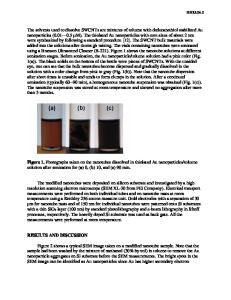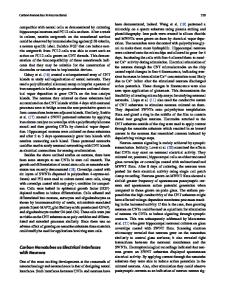Solubility of carbon nanotubes
- PDF / 109,051 Bytes
- 5 Pages / 612 x 792 pts (letter) Page_size
- 39 Downloads / 462 Views
Solubility of carbon nanotubes Marc in het Panhuis, Jonathan N. Coleman and Werner J. Blau Materials Ireland Polymer Research Centre, Department of Physics, Trinity College Dublin, Dublin 2, Ireland.
ABSTRACT We have described a novel experimental technique to separate nanotubes from other unwanted carbon species in arc generated carbon soot. A conjugated polymer was used to bind to nanotubes in solution. The resultant hybrid was soluble while extraneous carbon material formed a sediment at the bottom of the sample bottle. This process was monitored using electron paramagnetic resonance (EPR) which showed that 63% of nanotubes were kept in solution while 98.1% of impurities were rejected. Optimal polymer characteristics for nanotube solubility were identified using geometry optimisation and experimental evidence. It was calculated that a successful polymer has a flat shaped helical backbone with solvent solubilising groups projected outwards. This is achieved with the following polymer characteristics, two solvent solubilising groups on a twist allowing π-conjugated backbone. INTRODUCTION Carbon nanotubes (CT) have many wide ranging applications. It is envisaged that their excellent structural, mechanical and electronic properties can be used for example as reinforcement agents in space suits, radar absorbance material for stealth applications and recently as field emitters in display technology. The main impediments are controlling growth and properties of carbon nanotubes. An additional problem is processing raw nanotube containing material. In our group raw material is produced using the arc discharge method [1]. In this production method the carbon soot contains CT along with undesirable carbon impurities designated as graphitic particles (GP). However, at present, as-produced carbon soot remains low in nanotube content [2] while no quantitative techniques to analyse soot exists. It will be demonstrated that EPR can be used to identify carbon nanotubes and graphitic particle signals. This can be used to quantify if the polymer has been successful in separating the nanotubes from the graphitic particles. Based on their hydrophobic nature it was thought that CT would dissolve in a hydrophobic solvent such as toluene. However, nanotubes fall out of toluene solution. The reason for this is at present not well understood and falls outside the scope of this paper. It has been demonstrated that nanotubes can be rendered soluble using a polymer matrix [3]. The purpose of this paper is to make an attempt at identifying which polymer characteristics are necessary to hold a nanotube in solution combining computer simulation and experimental evidence. MATERIAL PRODUCTION AND CHARACTERISARION In order to produce the polymer nanotube composites poly(m-phenylenevinylene-co-2,5dioctyloxy-p-phenylenevinylene) (PmPV) [4] was mixed with multi wall carbon nanotubes A5.3.1
(MWNT) containing Krätschmer-generated [2] carbon soot in toluene. The mixture was then sonicated for 4 hours in a sonic bath. The solution was then allowed to
Data Loading...











